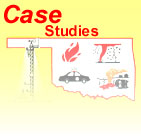Overview
The Oklahoma Fire Danger (OKFD) Model runs five times per
day, and generates valuable output in the form of several
fire danger indices. Like all models, it can best be used
when its components and their limitations are understood.
Perhaps the best way to learn about the OKFD Model is to
explore its response to real-time weather events. In addition to
real-time data, this lab exercise focuses on a five-day period when
several meteorological events occurred which revealed the
characteristics of the OKFD Model. None of the events (or the
model's response to them) were extreme by any means, but represent
what you might see on a typical week.
|
![]()
